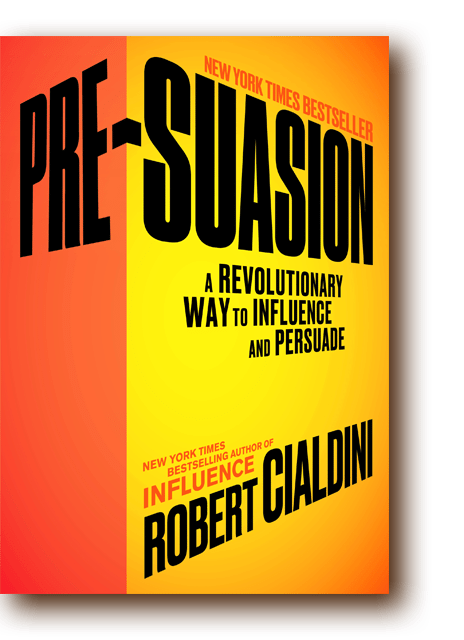
Business photo created by jcomp – www.freepik.com
Do you know that what happens BEFORE your marketing message is received influences your success? Or that WHO your audiences are is less important than WHERE their attention was just prior to receiving your offer?
Fans of marketing psychology—you’re in for a treat today!
In this article, you will learn vital lessons in social psychology and persuasion from Robert Cialdini’s excellent book Pre-Suasion: A Revolutionary Way to Influence and Persuade.
Famed for being the godfather of social influence (remember the 6 weapons of influence?), his latest book shows how marketers can capitalise on “privileged moments of change” to prime your audiences to be more receptive to your message before they encounter it.
To simplify the frameworks in the book, we will focus on its three key components:
- Front-loading of Attention: How privileged moments are developed, and how attention can be commanded
- Processes of Pre-suasion: What happens in your prospect’s mind during pre-suasion (and what you can do)
- Strategies for Pre-suasion: What are some of the best practices to persuade them
Ready to accelerate your marketing effectiveness?
Let’s go!
#1 How to Front-load Their Attention
To understand how attention is front-loaded in your prospect’s minds, consider what Cialdini defines as privileged moments, which can be defined as follows:
“Privileged moments are the moments that we create immediately before we present an idea or proposal or recommendation so that people are attuned to that idea, recommendation, or proposal before they ever encounter it.”—Robert Cialdini
Use these periods to “target chute” your audience so that they will have a more positive mindset towards your idea.
For example, if you are trying to get your prospect to enroll in a training programme, you could ask them a question like “Do you consider yourself as an active learner?” Your prospect’s need to ensure consistency pre-disposes them to respond favourably to your training course!
There are a few points here to take note of.
a) Achieve Prominence through Focus
Make the subject matter of your message salient. Draw attention to a specific related area right before that moment.
Here are some ways to do so:
- Manage the background. For example, if you wish to make people feel light-hearted, you may show them an image of “mrbean” before you present your message.
- Invite favourable comparisons. Focus on one good thing that your product or service have, rather than comparing all its features with your rivals’ features.
- Shift their focus. Draw selective attention to a particular favourable aspect of your product or service, eg how your camera lenses are the best in the industry.
b) What’s Focal is Causal
When you usher your audience’s attention to a selected dimension of your content, they will be more receptive to your message. They would then associate that specific item as the cause to an effect.
For instance, leaders are typically given a lot more credit for the success (or failure) of an organisation because of their prominence in the media or annual reports. Thus, because they’re psychologically salient (ie visible), they are deemed to be the cause of an event.
c) Ways to Attract Attention
To generate attention, consider using these strategies:
- Consider Sexual Imagery: Sex sells, and humans are drawn to sexy human images. However, consider their relevance to your product rather than to use them blatantly. (More on using sexual imagery in your advertising here.)
- Tap on Danger: Human attention is always immediately drawn to dread risks that may affect their well-being. This influences their subsequent behaviours. Thus, if you wish to get more people to buy your fire extinguisher, you should present scary statistics on media reports on fires.
- Use Conditioning: Consider how you can change your environment so that specific cues can be positively associated with your product or service.
- Adopt Self-Relevant Cues: These include using the word “you” instead of “she,” or you may wish to describe your potential prospect in detail so that they can self-select. (Develop a detailed customer profile and use it in your content.)
- Use the Unfinished: Do you remember the Zeigarnik Effect? Well, the goal here is to leave something unfinished—an incomplete story, unresolved problem, unanswered question or unachieved goal—to continually attract your audience’s attention.
- Make it Mysterious: Because mysteries require an explanation, your audience is more likely to desire what you have. Consider using these steps: pose the mystery; deepen the mystery; home in on a proper explanation; provide clue to the proper explanation; resolve the mystery; draw implications.
#2 How to Make Pre-suasive Processes Work
In this section, I will describe the neuro-biology and psychological aspects of association, ie how people link one thing to another.
a) Use The Right Language
Often, how we think is closely associated with the language of the communication that we’re exposed to.
There are several ways in which this can be made to work:
- Pre-expose Them to the Right Words or Images: Words can thrill, heal or kill—pre-expose your prospects to the right types of words to elicit the right actions. For example, if you’d like them to donate to your cause, consider using images of generous individuals or quotes on the virtue of donating.
- Metaphors be with You: Joseph Campbell famously said: “If you want to change the world, change the metaphor.” Use the right metaphors to associate your message with the right images. (More on marketing metaphors here.)
- Beware of Negative Associations: Attune yourself to cultural contexts and messages that could connote negatives. For instance “pre-owned” may be more positive than “second-hand.”
- Find a Commonality: Anything that is self-connected (or perceived to be so) gets a favourable uplift. For example, you can connect with others through their home-towns (a fellow Yishunite), occupations (“fellow entrepreneur”), institution (“alumni of NUS”), or language (eg using Hokkien to reach elders).
- Make it Easy (Fluent): The harder your prospect needs to think, the less likely they are to be influenced.
b) Use The Right Places
Your target audiences are more likely to respond favourably to your message if they’re pre-exposed to the right backgrounds. Termed your self-persuasive geography, it can also be used when you need to craft messages that have greater empathy.
For instance, if you wish to design a social media marketing campaign to reach youths-at-risk, it may make sense to paste some images of them on your desk. Or to work in a cafe where you may occasionally see them hanging around.
Self-influence can also be ignited by setting the right contexts (eg of success and victory) so that your prospect is in the right frames of mind prior to receiving your message.
c) Understand the Mechanics
There are several factors at play here—I’ll focus on the more important ones.
Your prospect’s minds are only triggered when they’re readied and waiting. Provoke consciousness in the important factor so that the other concepts not linked to your idea are suppressed.
There are three ways to invoke this connection:
- Prime Early: Give people cues that are appropriate to your task to elicit the right responses. For example showing people photos of people from different races working together well may lead to a person being more open to working in a foreign land.
- Use Close Associations: If you wish to persuade people to put on a mask during a health crisis, it will be better to focus on a message that say 95 percent of people wear masks when they’re sick. It may not be helpful to include a message that masks are cheap and easily available.
- Build Positive Associations: Use celebrities, thought leaders, and other persons of authority to positively link to your message or product.
- Invoke “If/When-Then” Plans: Inculcate the right habits in your prospects by wording your messages with these association, eg “Take a Break, Have a KitKat”
#3 Best Practices in Pre-suasion and Persuasion
To nudge people to move in the right direction, it is thus important to get them to do the right thing immediately before response.
To recap, let me cite these examples from the book:
If we want them to buy a box of expensive chocolates, we can first arrange for them to write down a number much larger than the price of chocolates.
If we want them to choose a bottle of French wine, play French background music first.
If we want them to try an untested product, we can ask if they consider themselves adventurous.
If we want them to choose a highly popular item, we can show them a scary movie first.
If we want them to feel warm towards us, get them to hold a hot drink.
If we want them to be more helpful to us, we can have them look at photos of individuals standing close to each other.
If we want them to be more achievement oriented, we can provide them with images of sports victory.
If we want them to make careful assessments, we can show them a picture of Auguste Rodin’s The Thinker

But how should you then act if you want them to be influenced and persuaded? Read on!
a) Use the Six Weapons of Influence
In the book, Cialdini recapped the six principles of influence that was covered in his earlier volume Influence. These can be used to “influence recipients toward assent” and are as follows:
- Reciprocation: People will feel a need to reciprocate a gift from another party, especially if it is meaningful, unexpected, and customised
- Liking: Your prospect will tend to like those who are more like them—show how similar you are, and show them with compliments!
- Social Proof: Provide evidence of comparable others acting in the way which you’d like them to act
- Authority: Use the right figures of authority—ensure that they’re trustworthy by perhaps being transparent about their weaknesses, and similar too
- Scarcity: This triggers our fear of losses, and can be used by telling people how scarce an item is (eg “only X copies per customer”)
- Consistency: Tap on the need for your potential customers to be consistent to their prior commitments. Use surveys that get them to respond affirmatively to a particular trait (“Do you consider yourself to be a brave person?”) before you present the ask (“Learn to be an entrepreneur now!”)
b) Foster Unity
There are several ways to tap on your target audience’s desire for social connections. Your goal is to increase the overlaps between their sense of self and others—which in this case, could be you, your brand or your product.
- Communicate Kinship: Establish your brotherhood, sisterhood or talk about your common ancestry of heritage.
- Talk about Home: Resonate with your audience through the physical proximity, eg “As fellow Singaporeans, we understand how it feels to….”
- Locality or Region: Strike a chord with the widest circle you can draw together, eg “Being members of ASEAN” or “As tropical islanders, we appreciate this….”
- Act Together: Find a way to synchronise an experience with your prospect. For example, you can get them to touch their hair while you’re touching yours. Or follow you in tapping on their tables to a rhythm.
- Co-Create Something: Sometimes, getting your customer to invest their time and energies in an endeavour will make them like it better. A.K.A. the IKEA effect.
- Ask for Advice: Find a way to seek the active participation of your prospect or customer in improving what you do—this should be as specific as possible.
c) How to Ensure Long-Term Effects
To persuade your prospect to maintain their changed position, there are two strategies proposed by Cialdini.
#1 Get Them To Commit
Make your prospect commit to her response by taking an active step. This could include writing down what she will do next, or publicly declaring it on social media.
Note that when doing so, it may be useful to expose them to imagery or words that reinforce that frame of mind, eg show them an image of a successful CEO when they commit to your leadership course.
#2 Align Your Social Cues
Choreograph your prospect’s experiences through different touch-points that they may encounter. Thus, it is useful to cue your cues so that they are more likely to stick to their decision and continue along the same path.
Conclusion
In the book, Cialdini further dedicated an entire chapter to the ethics of using social influence strategies such as pre-suasion, and why companies should seek to be honest and truthful when they use such tools. From numerous studies shown, manipulative companies often reach a downfall—dishonesty doesn’t pay.
I hope that you’ve found this summary useful. What I’ve covered are just the key ideas and frameworks—you need to get a copy of the book and read it to fully absorb Robert Cialdini’s wisdom and insight.
Which of these pre-suasion methods will you start using? How would you apply them?

